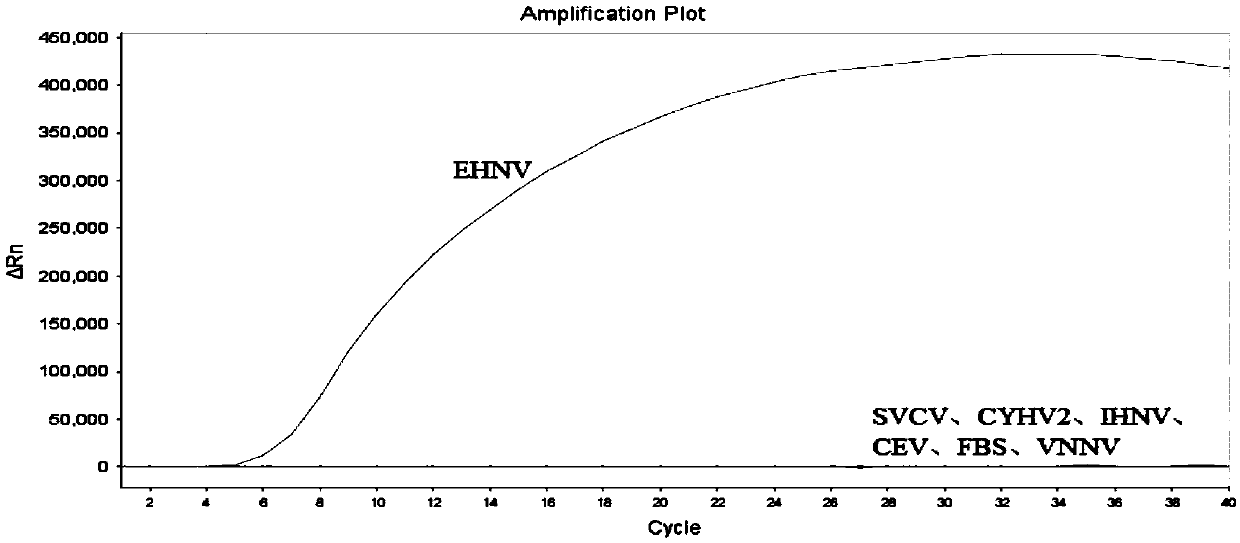RAA constant-temperature fluorescence detection method and reagent for epidemic hematopoietic organ necrosis virus (EHNV)
A hematopoietic organ necrosis and detection kit technology, applied in the field of molecular biology, can solve the problems of expensive equipment, high technical requirements, unsuitable on-site detection and popular use, etc., and achieve the effect of simple identification and simple operation
- Summary
- Abstract
- Description
- Claims
- Application Information
AI Technical Summary
Problems solved by technology
Method used
Image
Examples
Embodiment 1
[0031] The present invention searches the gene sequence of the epidemic hematopoietic organ necrosis virus strain in the Genebank database, uses DNAMAN 6.0 software to compare multiple sequences, and finds out the conserved segment. Four sets of primers and probes were designed in the conserved regions, and BLAST comparison was performed in the NCBI database. The sequences of the primers and probes are shown in Table 1. The positive sample amplification curve is as follows figure 1 shown.
[0032] Table 1 primers and probe sequences:
[0033]
[0034] Depend on figure 1 The results show that the amplification curves of the fourth group of primers and probes are the most typical, with obvious exponential phase and plateau phase, higher fluorescence intensity (ordinate value), and smaller CT value (the intersection of the curve and the threshold line Corresponding abscissa) result analysis is shown in Table 2. For other primers and probes, the rising height of the curve i...
example 3
[0047] Example 3: Kit of the present invention epidemic hematopoietic necrosis virus
[0048] 1. Extraction of positive sample nucleic acid
[0049] 1.1. Nucleic acid extraction: use traditional Trizol-RNA reagent or an equivalent RNA extraction kit.
[0050] 2. The configuration of the RAA reaction system: each test sample corresponds to a RAA reaction dry powder tube, and the reaction components and the added volume in each RAA reaction dry powder tube are shown in Table 3.
[0051] table 3:
[0052] RAA reaction system components Volume (μL) A Buffer 12.5μL B Buffer 2.5μL primer mix 4μL specific fluorescent probe 0.6μL RNA template 2μL DEPC treated water 28.4μL total capacity 50μL
[0053] A Buffer is 20% PEG; B Buffer is 280mM MgAc
[0054] 3. Place the RAA reaction tube with the reaction system in the ABI7500 amplification instrument, and carry out RAA amplification according to the following procedure: 3...
Embodiment 4
[0057] Embodiment 4: Evaluation of the RAA detection kit of the present invention in clinical practice
[0058] The kit of the present invention was used to carry out a clinical blind experiment, and 20 large yellow croakers were detected; the experimental results showed that the fourth primer pair of the present invention can distinguish epidemic hematopoietic organ necrosis virus, and the positive coincidence rate with reverse transcription PCR is very high. Among the 20 samples, reverse transcription PCR, 16 samples were positive results, 4 samples were negative results, 4 samples were positive results detected by the RAA method, and 4 samples were also negative results. The results of the two groups of experiments were consistent. It shows that the RAA detection of the present invention has the same reliability as the PCR detection.
PUM
 Login to View More
Login to View More Abstract
Description
Claims
Application Information
 Login to View More
Login to View More - R&D
- Intellectual Property
- Life Sciences
- Materials
- Tech Scout
- Unparalleled Data Quality
- Higher Quality Content
- 60% Fewer Hallucinations
Browse by: Latest US Patents, China's latest patents, Technical Efficacy Thesaurus, Application Domain, Technology Topic, Popular Technical Reports.
© 2025 PatSnap. All rights reserved.Legal|Privacy policy|Modern Slavery Act Transparency Statement|Sitemap|About US| Contact US: help@patsnap.com



